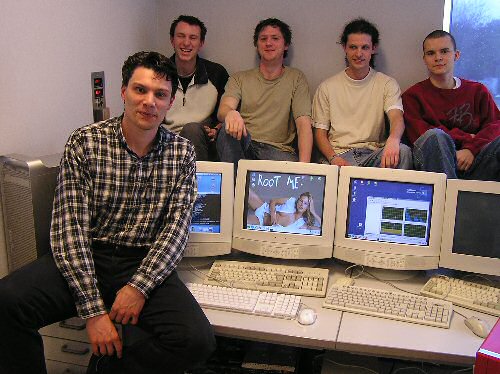No more mysteries: Apple's G5 versus x86, Mac OS X versus Linux
by Johan De Gelas on June 3, 2005 7:48 AM EST- Posted in
- Mac
Benchmark configuration
We used the MySQL version (4.0.18) that came with the SUSE SLES9 CD's and Mac OS X Tiger 10.4.1, which was certified to work on our OS.Software: Intel, AMD
SUSE SLES 9 (SUSE Entreprise Edition) , Linux kernel 2.6.5, 64 bit.
Workstation tests: Windows XP SP2
Software: Apple PowerMac G5
OS X 10.4.1 Tiger, 64 bit (partially).
Software: common
MySQL 4.0.18, 32 and 64 bit, MyISAM engine
Gcc 3.3.3
Hardware
Here is the list of the different configurations:Apple PowerMac Dual 2.7 GHz, Dual 2.5 GHz
4 GB (8x512 MB) Corsair XMS3200 running at CAS 3-3-3
Intel® Server Board SE7520AF2
4 GB (4x1024 MB) Micron Registered DDR-II PC2-3200R, 400 MHz CAS 3, ECC enabled
NIC: Dual Intel® PRO/1000 Server NIC (Intel® 82546GB controller)
Dual Xeon DP Galatin 3.06 GHz 1 MB L3-cache, 533 MHz FSB
Intel SE7505VB2 board - Dual DDR266
2 GB (4x512 MB) Crucial PC2100R - 250033R, 266 MHz CAS 2.5 (2.5-3-3-6)
NIC: 1 Gb Intel RC82540EM - Intel E1000 driver.
Opteron Server: Dual Opteron 250 (2.4 GHz)
Iwill DK8ES Bios version 1.20
4 GB: 4x1GB MB Reg. Transcend (Hynix 503A) DDR400 - (3-3-3-6)
NIC: Broadcom BCM5721 (PCI-E)
MSI K8T Master1-FAR
4x512 MB infineon PC2700 Registered, ECC enabled
NIC: Broadcom 5705
Shared Components
1 Seagate Cheetah 36 GB - 15000 rpm - 320 MB/s
Maxtor 120 GB DiamondMax Plus 9 (7200 rpm, ATA-100/133, 8 MB cache)
Words of thanks
A lot of people gave us assistance with this project, and we like to thank them of course:Frank Balzer, IBM DB2/SUSE Linux Expert
Jasmin Ul-Haque, Novell Corporate Communications
Matty Bakkeren, Intel Netherlands
Trevor E. Lawless, Intel US
Larry.D . Gray, Intel US
Damon Muzny, AMD US

My team and I at the Technical University in the lab. Notice the slick Power Mac system behind me.
Bert Van Petegem, DB2 Expert
Ruben Demuynck, Vtune and OS X expert
Yves Van Steen, developer Dbconn
David Van Dromme, Iwill Benelux Helpdesk (http://www.iwill-benelux.com)
I also would like to thank Lode De Geyter, manager of the PIH, for letting us use the infrastructure of the TUK ( www.pih.be) to test the database servers.










116 Comments
View All Comments
tfranzese - Friday, June 3, 2005 - link
Kind of snappy there Johan.I do prefer numbers coming from one source myself.
JohanAnandtech - Friday, June 3, 2005 - link
Rubikcube: Speculative? Firstly, Both a webserver and a database server show terrible performance. Secondly, LMbench shows there is definitely a problem with creating threads. So everything point into our "speculative" conclusion.Thirdly, as mentioned in an earlier post:
http://www-106.ibm.com/developerworks/linux/librar...
is another indication that there is nothing speculative about our conclusion.
rubikcube - Friday, June 3, 2005 - link
#21 I disagree. Most of the end of the article on the threading problems was speculative. We can't say that's the cause without actual testing.Jalf - Friday, June 3, 2005 - link
To those wanting a Linux on G5 test, keep in mind the entire purpose of this article. It was to test the performance of a Mac computer running a Mac OS, compared to a Intel/AMD PC.So while installing Linux on the G5 would give us a better idea of how the CPU itself performs, it would also leave out the huge effect the OS also has (You wouldn't have seen the huge performance problems with threading, for example.)
Jalf - Friday, June 3, 2005 - link
#11: Not true, if you browse AMD's documentation for a bit, they do say that their TDP *is* the absolute max power.Intel uses the "maximum power achievable under most circumstances"-method though.
rubikcube - Friday, June 3, 2005 - link
I agree that linux should have been used for a more normalized comparison. I also think that you should have tried running your mysql tests from darwin on x86. You might have been able to find the cause of the performance anomalies.Sabresiberian - Friday, June 3, 2005 - link
I find it hilarious that someone calling him- or herself 'porkster' is complaining about someone else's language :)Apple's computers have made their fame on their user-friendliness, so I think it is very appropriate to compare these computers with OSX on the Apples, as that's where the user-friendliness resides and both OSes are in the same family. It would have been fun to compare using the 64 bit Win XP Pro - I bet we would all get a good laugh out of that. Microsoft is determined, I think, to make a Linux man out of me yet :)
kresek - Friday, June 3, 2005 - link
waiting for AnandTech's YDL results, have a look at this:http://www-106.ibm.com/developerworks/library/l-yd...
SMOG - Friday, June 3, 2005 - link
#13 Thresher: "When it comes down to it, performance is important, but not the only reason people buy what they buy. I would say more often than not, the decision is made with only a modicum of logic."Your right, and those people didn't read this article, at best they read the first page then skipped to the last to see if he bashed Apple or not. This article was for those who want to know just what the power of the PowerPC actually is. This is a technical artical, not a buyers guide. This is science.
Good Job.
CU - Friday, June 3, 2005 - link
You mentioned most people don't use the Intel compiler, but it would have been nice to see it and also the windows compiler and the ibm compiler.